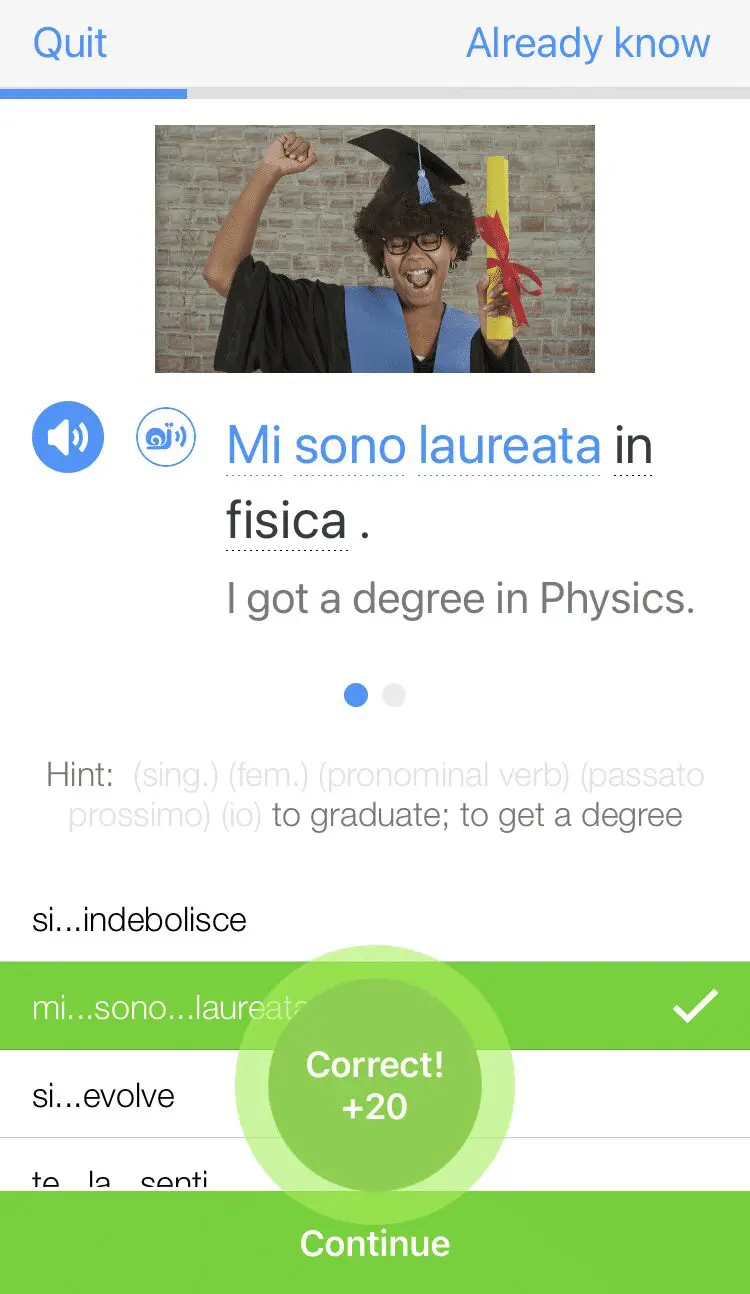How to Use Commands in Italian

Dimmi l’ora. (Tell me the time.)
Fammi sapere. (Let me know.)
Aspetta! Lasciami pensare! (Wait! Let me think!)
All of those sentences use the Italian command form (also known as the imperative form) which is used to make direct suggestions or give orders. You’re going to need to understand it and use it in just about any conversation.
Read on to learn all about Italian commands in the tu, Lei, noi and voi forms and see them used in example sentences.
Download: This blog post is available as a convenient and portable PDF that you can take anywhere. Click here to get a copy. (Download)
Considerations for Learning Italian Commands
Despite what I said about imperatives being very common, this is more of an intermediate-level grammar topic.
If you’re just starting out, you can use this post to familiarize yourself with the imperative form anyway. You might come across it in beginner books, songs, videos or podcasts. But to learn to form it yourself, you’ll have a much easier time if you already know and understand the Italian present indicative and the present subjunctive.
It’s also wise to first understand the Italian object pronouns and reflexive pronouns (including how they combine with verbs).
As with the present tense and other conjugations, the Italian imperative changes depending on the verb’s subject. That is, you’ll use different forms of the verbs depending on the person you’re bossing around.
For this reason, it’s easiest to learn each form of the imperative separately.
I’ll start this article with the trickiest form, tu (informal singular “you”).
Then we’ll look at Lei (formal singular “you”) and finish with the easier noi (“we”) and voi (plural “you”) forms.
I’ll also cover the dreaded irregular verbs that follow none of the rules.
Note that, when we make a command in Italian, we don’t actually include any of the above subject pronouns (tu, Lei, noi, voi) in our sentences. In the third example above we saw just “aspetta”—not “tu aspetta,” which would sound strange.
Also note that Italians are more liberal with their sprinkling of exclamation points after commands than English writers tend to be.
Tu Commands in Italian
We use tu to address a single person informally in Italian.
The tu command form comes up quite a lot. After all, who do we boss around more than the people we’re closest to?
The tu section of this article is the longest and most complicated. For example, you’ll notice that tu has different positive and negative command forms.
But don’t lose hope here at the outset!
I’ve broken tu into easy-to-swallow subsections. It’s more fun and useful to spend a full study session learning and practicing each of these separately.
I also promise that there’s light when you come out the other end of this section. The other imperative subject conjugations are much simpler.
Positive tu commands with -are verbs
The positive imperative tu form of verbs ending in -are is the same as the conjugations you first learned for lui/lei.
You’ll just end these tu commands with –a.
In other words, the positive imperative tu form is the same as the present tense third-person indicative form. (I know that sounds complicated, but present tense indicative is just the “normal” present tense.)
So, let’s try this with the verb guardare (to watch). First, we take the verb’s third-person indicative form, lui guarda (he watches). Then we repurpose it to give an informal order to a single person.
Guarda attentamente. (Watch carefully.)
Not too bad, right?
Another example:
Mischiare (to combine) → lui mischia (he combines)
Mischia l’aceto con l’olio d’oliva. (Combine the vinegar with the olive oil.)
Positive tu commands in Italian with –ere and –ire verbs
The positive imperative tu form with –ere and –ire verbs is easier.
It’s exactly the same as the present tense indicative (“normal”) tu form.
| Verb | Tu command form | Example |
|---|---|---|
| Mettere (to put) | tu metti (you put/put!) | Metti l’altoparlante sulla mensola. (Put the speaker on the shelf.) |
| Finire (to finish) | tu finisci (you finish/finish!) | Finisci la minestra. (Finish the soup.) |
| Aprire (to open) | tu apri (you open/open!) | Apri la valigia. (Open the suitcase.) |
This pattern holds for most verbs that have irregular present tense indicative tu forms.
| Verb | Tu command form | Example |
|---|---|---|
| Scegliere (to choose) | tu scegli (you choose/choose!) | Scegli un argomento. (Choose a topic.) |
| Tenere (to hold) | tu tieni (you hold/hold!) | Tieni duro! (Hang in there/you’ll survive! [Literally "Hold hard!"]) |
| Uscire (to go out) | tu esci (you go out/get out!) | Esci da qui! (Get out of here!) |
Using pronouns with positive tu commands
With positive tu commands, the object pronouns and reflexive pronouns (lo, ci, te, etc.) come after the verb and are attached to it, and the result is spelled as a single word.
Mettilo qua! (Put it here!)
Mangialo! (Eat it!)
Lavati i denti! (Brush your teeth!)
Note: There are a few irregular spelling changes that can take place with pronouns and tu commands, as described in the next section.
The very irregular but also very useful positive tu commands
There are eight (and thankfully only eight) verbs that don’t follow the above patterns for positive tu commands, nor any other real pattern.
You’ll absolutely want to memorize all of them as they’re also quite common.
Below are the eight verbs with their conjugations and examples of how they can be used in context.
Spelling note: When followed by a pronoun, the forms da’, di’, fa’, sta’ and va’ listed below cause the pronoun’s initial consonant to double. The example of this that you’ve likely already seen is dimmi (tell me) rather than dimi. There are other examples of this shown with the various verbs below.
Also, where used, the apostrophes are important. They distinguish the written verbs from other short words in Italian that are spelled the same. For example, di’ means “Say!” whereas di is the preposition meaning “of,” “from” or “by.”
For the verbs that have two conjugations, both are correct and are often used interchangeably. However, for andare, the first tends to be used more for making suggestions and the second for giving orders.
| Verb | Tu command | Examples |
|---|---|---|
| Andare (to go) | va’ / vai (you go/go!) | Va’ a Roma domani.
(Go to Rome tomorrow.) Vai a Roma domani. (Go to Rome tomorrow.) Va’ dove ti porta il cuore. (Go wherever you like. [Literally "Go where your heart brings you."]) Vai a quel paese! (Stay away from me!/Get the hell away from me! [Literally "Go to that land!"]) |
| Avere (to have) | abbi (you have/have!) | Abbi cura di te.
(Take care of yourself, take a break. [Literally "Have treatment of you."]) Abbi pazienza. (Be patient. [Literally "Have patience."]) |
| Dare (to give) | da' / dai (you give/give!) | Da' lo zaino a tuo zio.
(Give the backpack to your uncle.) Dai ascolto a tuo padre. (Listen to your father. [Literally "Give listening to your father."]) Dammelo. (Give it to me.) Dallo ai tuoi genitori. (Give it to your parents.) |
| Dire (to tell/to say) | di' (you say/say!) | Di’ cosa ne pensi del viaggio.
(Say what you think of the trip.) Di’ la verità! (Tell the truth!) Di’ la tua. (Say your piece. [Literally "Tell yours."]) Diccelo. (Tell us it.) |
| Essere (to be) | sii * (you are/be!) | Sii forte!
(Be strong!) Sii cauto. (Be cautious.) |
| Fare (to do/to make) | fa' / fai (you do/do!) | Fa’ quello che vuoi!
(Do what you want!) Fai attenzione. (Pay attention.) |
| Sapere (to know) | sappi (you know/know!) | Sappi che questa valigia è molto pesante e non ti conviene!
(Know that this suitcase is very heavy and isn’t right for you!) Sappi che ho passato una bellissima giornata con te. ([You should] know that I have spent a lovely day with you.) |
| Stare (to be [temporarily]/to be located/to stay) | sta' / stai (you are/be!) | Sta’ attento!
(Pay attention!) Stai zitto! (Be silent!) Sta’ fermo! (Stand there!/Don’t move! [Literally "Be stationary!"]) Sta’ qui! (Stay here!) |
*This is a two-syllable word. Remember to pronounce both i’s!
Negative tu commands
Once you’ve mastered the positive tu commands, things get much easier.
In all cases, negative tu commands are simply the same as the imperative form of the verb, with a non in front of it.
So:
Mischiare (to mix) → Non mischiare! (Don’t mix!)
Non mischiare i frutti di mare con il formaggio! (Don’t mix seafood with cheese!)
Similarly:
Non sporcare la forchetta! (Don’t get the fork dirty!)
Non ordinare, non siamo ancora pronti. (Don’t order; we’re not ready yet.)
Non bere! (Don’t drink.)
With negative tu commands, reflexive and object pronouns can come either before or after the verb, as you wish.
If they come after, the final –e is removed and they’re written as a single word (as you’ve likely already seen with pronouns added to infinitive forms).
Non dirmelo! / Non me lo dire! (You don’t say!/That’s crazy! [Literally “Don’t tell me it!”])
Here are some more examples with pronouns:
Non dirmi cosa devo fare! (Don’t tell me what to do!)
Non farlo! (Don’t do it!)
Positive and Negative Lei Commands
These imperative conjugations are used for telling a single person, formally, what to do.
If you’ve learned your present subjunctive well, they’re quite easy.
That’s because the Lei form of the indicative is the same as the Lei form of the subjunctive (whether regular or irregular, and whether it’s an –are, –ere or –ire verb).
So:
Prendere (to take) → prenda (you take/take!)
Prenda il libro. (Take the book.)
Here are more examples of formal commands that you might issue to a single person.
| Verb | Lei command form | Example |
|---|---|---|
| Preparare (to prepare/to pack) | prepari (you prepare/pack!) | Prepari lo zaino. (Pack your backpack.) |
| Salire (to get in) | salga (you get in/get in!) | Salga in macchina. (Get in the car.) |
| Prendere (to take) | prenda (you take/take!) | Prenda le sue cose. (Take your things.) |
| Finire (to finish) | finisca (you finish/finish!) | Finisca il suo discorso. (Finish your speech.) |
| Uscire (to go out) | esca (you go out/get out!) | Esca da qua. (Get out of here.) |
| Bere (to drink) | beva (you drink/drink!) | Beva questa tisana. (Drink this herbal infusion.) |
| Lavare (to wash) | lavi (you wash/wash!) | Lavi i piatti. (Wash the dishes.) |
Negative Lei commands follow the same pattern.
Non mi dica questo. (Don’t tell me this.)
Non ordini la pizza. (Don’t order the pizza.)
Non lasci il bagno sporco. (Don’t leave the bathroom dirty.)
Unlike with the other command forms, when addressing someone with Lei, the pronouns always come before the verbs.
Lo prenda! (Take it!)
Lo dica! (Say it!)
Lo prepari! (Prepare it!)
Non lo faccia! (Don’t do it!)
Positive and Negative Noi and Voi Commands
Noi is the first-person plural (“we”), so it’s used in the command form like an equivalent of “Let’s…”
Voi is the second-person plural, and it’s used for telling two or more people what to do.
Sometimes, in some southern parts of Italy, especially among older people, voi is also the second-person formal singular—and thus used for telling a single person, formally, what to do.
Noi and voi imperative conjugations are simply the same as their present tense forms (whether those forms are regular or irregular).
So when you’re making a suggestion for what to do with your group, you’ll use the same conjugation as the noi present tense, but without actually saying the word noi.
| Verb | Noi conjugation | Example |
|---|---|---|
| Andare (to go) | andiamo (we go/let's go!) | Andiamo al cinema! (Let’s go to the movie theater!) |
| Prendere (to take) | Prendiamo (we take/let's take!) | Prendiamo il treno! (Let’s take the train!) |
| Uscire (to go out) | Usciamo (we go out/let's go out!) | Usciamo! (Let’s go out!) |
| Cenare (to eat dinner/to dine) | Ceniamo (we have dinner/let's have dinner!) | Ceniamo al ristorante! (Let’s dine at the restaurant.) |
Likewise, when you’re telling a group of people what to do, you use the same conjugation as present-tense voi.
| Verb | Voi conjugation | Example |
|---|---|---|
| Pulire (to clean) | pulite (you clean/clean!) | Pulite le vostre scarpe. (Clean your shoes.) |
| Prendere (to take) | prendete (you take/take!) | Prendete il percorso riservato alle biciclette. (Take the path that's reserved for bicycles.) |
| Andare (to go) | andate (you go/go!) | Non vi voglio vedere più, andate via! (I don't want to see you guys anymore, go away!) |
The negative forms of noi and voi commands are the same.
Non portiamo troppi pesi nello zaino. (Let’s not take too much weight in the backpack.)
Non andiamo troppo in fretta. (Let’s not rush.)
Non corriamo troppo. (Let’s not hurry too much.)
Pronouns are attached to the end of noi and voi commands and the results are written as single words.
Prendiamolo. (Let’s take it.)
Datemelo! (Give it to me!)
Andatevene!
(Get out of here!)
(This is a tacking-on of both the ve and ne pronouns; recall that ne can mean “of something.”)
There are three irregular voi command forms to memorize.
They might look familiar, though. With these three verbs, instead of using the indicative voi form for voi commands, you use the subjunctive.
| Verb | Irregular voi conjugation | Example |
|---|---|---|
| Avere (to have) | abbiate (you have/have!) | Abbiate fiducia in me. (Trust me.) |
| Essere (to be) | siate (you are/be!) | Siate pazienti con loro.
(Be patient with them.) "Siate affamati. Siate folli." ("Stay hungry. Stay foolish.")* |
| Sapere (to know) | sappiate (you know/know!) | Sappiate quando dire no. (Know when to say no.) |
*This is the typical Italian translation of the motivational quote made famous by Steve Jobs.
Three Bonus Uses of the Italian Imperative
There are three Italian verbs that are sprinkled throughout conversations in their imperative forms.
They’re so common that they serve more as interjections than what you might think of as “commands.”
These are:
- Ma dai!
(Come on!/No way!)
The above is usually said with encouraging enthusiasm or disbelief. Literally it means “but give.” If you’re spouting some bullcrud and your Italian interlocutor says this, it’s a playful invitation to keep going!
- Ma va’!
(Go on!/You don’t say!)
This is also an expression of incredulity similar to that above. It literally translates to: “but go!”
How to Learn and Practice Italian Commands
If you’ve made it this far and you want even more, I highly recommend the imperative and pronoun explanations in the grammar textbook “Soluzioni: A Practical Grammar of Contemporary Italian.” There are also written exercises for practice.
If you already have a good level of comprehension of written Italian, you can check out this encyclopedia chapter on the imperative mood, its uses and the controversial aspects from the point of view of Italian speakers. (There are four grammatical moods in Italian; the other three are the indicative, subjunctive and conditional.)
It’s interesting to see what troubles Italian speakers about this mood when they’re evaluating their own use of the language.
You can also listen to how native speakers use commands in their daily speech through authentic Italian videos on the FluentU learning program.
FluentU takes authentic videos—like music videos, movie trailers, news and inspiring talks—and turns them into personalized language learning lessons.
You can try FluentU for free for 2 weeks. Check out the website or download the iOS app or Android app.
P.S. Click here to take advantage of our current sale! (Expires at the end of this month.)
And finally there’s a number of websites where you can get decent information and practice the conjugations you’ve just learned.
Now that you’ve learned about Italian commands, it’s time to start using them in your own conversations!
Divertiti! (Have fun!)
Download: This blog post is available as a convenient and portable PDF that you can take anywhere. Click here to get a copy. (Download)
And One More Thing...
If you're as busy as most of us, you don't always have time for lengthy language lessons. The solution? FluentU!
Learn Italian with funny commericals, documentary excerpts and web series, as you can see here:

FluentU helps you get comfortable with everyday Italian by combining all the benefits of complete immersion and native-level conversations with interactive subtitles. Tap on any word to instantly see an image, in-context definition, example sentences and other videos in which the word is used.

Access a complete interactive transcript of every video under the Dialogue tab, and review words and phrases with convenient audio clips under Vocab.

Once you've watched a video, you can use FluentU's quizzes to actively practice all the vocabulary in that video. Swipe left or right to see more examples of the word you’re on.

FluentU will even keep track of all the Italian words you’re learning, and give you extra practice with difficult words. Plus, it'll tell you exactly when it's time for review. Now that's a 100% personalized experience!
The best part? You can try FluentU for free with a trial.
Start using the FluentU website on your computer or tablet or, better yet, download the FluentU app from the iTunes or Google Play store. Click here to take advantage of our current sale! (Expires at the end of this month.)









